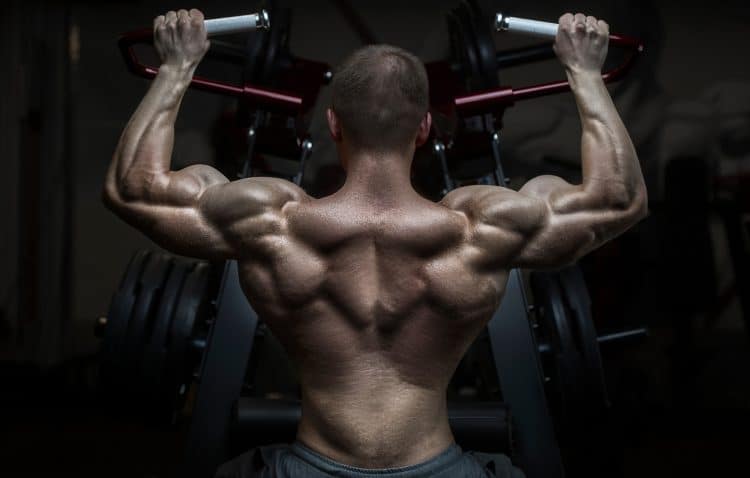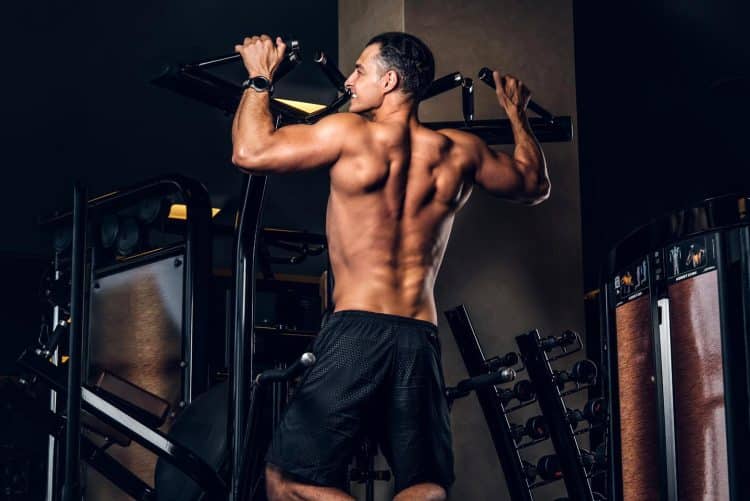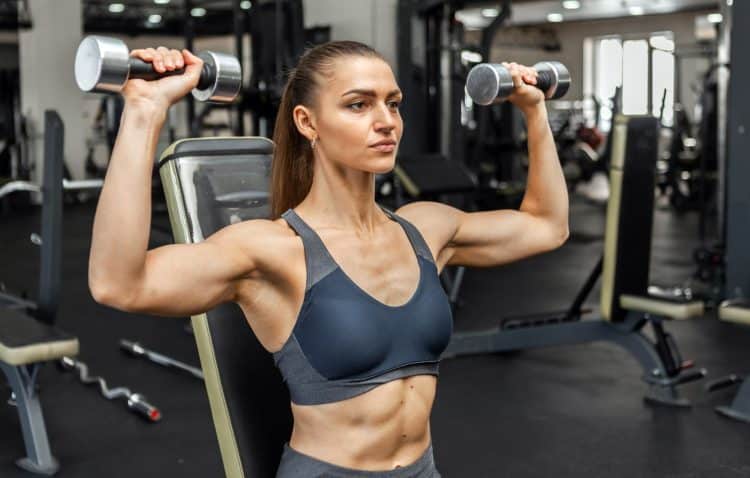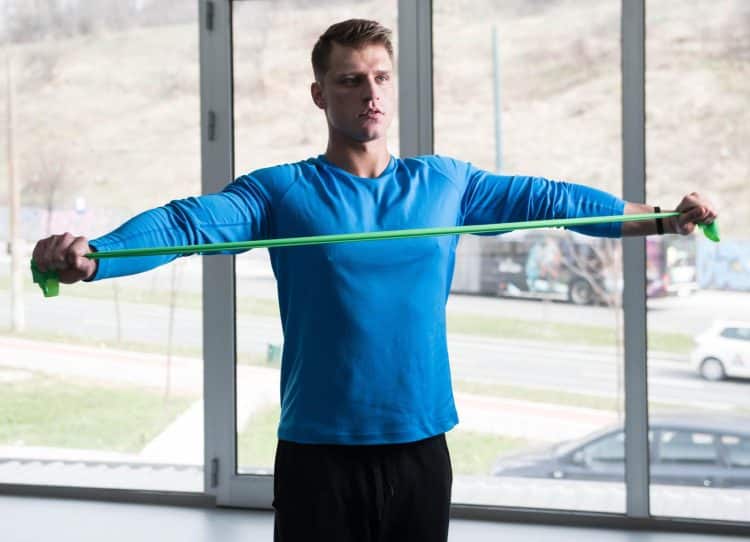A thick wide back, set off with capped boulder shoulders, is the trademark of a bodybuilding physique. Experts will tell you that bodybuilding competitions are won from the back, but even from the front, fully developed back and shoulder muscles create the ideal V-shaped silhouette we all admire.
Even if you’ve got no intention of stepping on a bodybuilding stage, maxing out your back and shoulder development will help you create the “X” shape emblematic of athleticism and fitness. Working your back and shoulders together is a great way to focus on these muscle groups.
In the following paragraphs, I’ll lay out a complete back and shoulder workout for building mass and detail. I’ll also provide a resistance band workout for those training at home and offer tips for maximizing your training and avoiding common back and shoulder training mistakes.
Back and Shoulder Anatomy
By exploring the anatomy of a muscle group, we can better identify the best exercises to work it. An effective exercise will follow the direction of the muscle fiber from its origin to its insertion point. So, when we study muscle structure, we learn how to select the movements that provide the best results for the effort expended.
Back Anatomy
When talking about the back, most people are referring to the latissimus dorsi (or lats). The lats are the largest muscle of the upper body, running from the lower spine and flaring up and out to the upper arm. But the lats are just one of the back muscles. There’s also the trapezius, the second largest muscle of the upper body, and the teres major, infraspinatus, and teres minor. Then there’s the erector spinae.
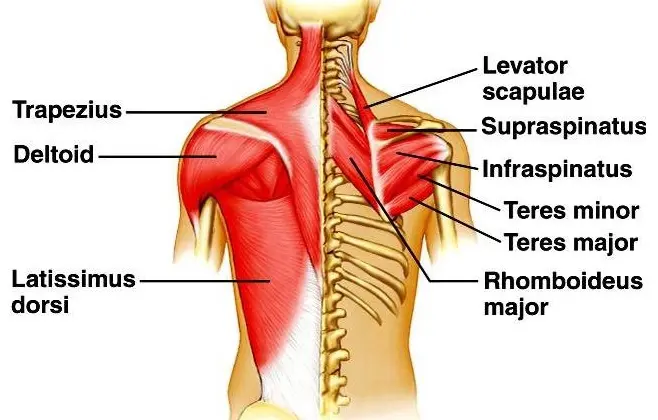
Let’s learn about the anatomy of each black muscle:
Level Up Your Fitness: Join our 💪 strong community in Fitness Volt Newsletter. Get daily inspiration, expert-backed workouts, nutrition tips, the latest in strength sports, and the support you need to reach your goals. Subscribe for free!
Latissimus Dorsi
The lats have their origin on the lower spine, the lower ribs, the bottom of the scapula (shoulder blade), and the top of the pelvis. The muscle fibers travel diagonally to insert in the armpit area, at the base of the humerus (upper arm) bone.
The muscle fiber direction gives a big clue as to the ideal exercises to work the lats. As the lat muscle fibers run diagonally from the armpit down to the hip and lower-mid back, the ideal movement to work the lats through their full range of motion would be an exercise that brings the arms from an up and outward position down and in towards the hip.
Trapezius
The trapezius (or traps) is a kite-shaped muscle that covers the upper thirds of the mid back. The trapezius muscle fibers insert at the base of the neck and then travel diagonally to the outer edge of each scapula. Other fibers run from the tip of the scapula down and into the mid-spine to create the trapezium shape that gives the muscle its name.
Traps enable pulling the shoulder and scapula toward the ears and the scapula back and in toward the spine. An effective trap workout will cover both of these movements.
Teres Major & Minor
The teres major is a small triangular-shaped muscle that sits just above the outer part of the lats. This muscle pulls the upper arm in and down. It gets plenty of work from lat-focused exercises and does not require a special exercise for full stimulation.
The teres minor is even smaller, lying between the teres major and the infraspinatus. Its main function is to rotate the upper arm externally. It gets a good workout every time you train your rear deltoids.
Infraspinatus
The infraspinatus muscles lie between the trapezius, rear deltoid, and lats. Its muscle fibers run from the edge of the scapula to the head of the humerus. It assists in rotating the upper arm externally. This muscle gets an effective workout when you do rear delt exercises.
Erector Spinae
The erector spinae is a band of muscle running along either side of the spine, from the base of your neck to your pelvis. Its function is to extend the back and bring it back to an upright position in response to the crunching action of the abdominals.
Shoulder Anatomy
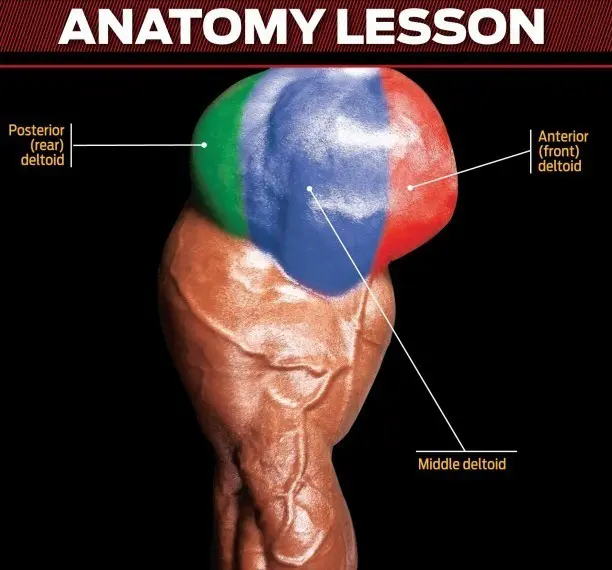
The deltoid muscle group is made up of three heads:
- The anterior head (front delt)
- The lateral head (side delt)
- The posterior head (rear delt)
Unlike the triceps, which also has three heads, each deltoid head has a separate function with a unique movement path. That is because they have unique points of muscle fiber origin and insertion. As a result, deltoid training is unique in that different exercises are needed to work each of the heads.
The anterior deltoid originates on the outer half of the clavicle and inserts on the deltoid tuberosity on the humerus (upper arm). This is right alongside the insertion of the lateral head, which originates on the outer edge of the acromion process. The posterior deltoid originates on the upper ridge of the scapula and inserts on the deltoid tuberosity of the humerus alongside the other two heads.
- The main function of the anterior head is to pull the humerus forward and upward towards the clavicle.
- The function of the lateral head is to raise the arm to the side.
- The primary function of the posterior head is to pull the arm back and, to a much lesser degree, to rotate the humerus externally.
Should You Train Back & Shoulders in the Same Workout?
Training back and shoulder in the same workout makes a lot of sense. When you train your back, your shoulders are relatively inactive. For instance, when you work your lats, the biceps, rather than the deltoids, act as a secondary working muscle.
Compare that to what happens when you train your chest and shoulders together, which is a common combination. The front deltoids are heavily involved in pressing movements such as the bench press, push-up, or dumbbell fly. So, after your chest workout, your shoulders are likely to be already fried, preventing you from going heavy or pushing your workout intensely.
Because working one muscle doesn’t affect the other, you can change the order of working the muscles as needed. So, if your shoulders are lagging, work them first. Then again, if your back needs to catch up, train it first.
Again we can contrast this with working the chest and shoulders together. If you worked your delts first, you would severely compromise your strength in heavy chest exercises like the flat or incline bench press.
You can also train your back and shoulder using supersets. This involves doing a back exercise and moving directly to a shoulder movement without stopping for rest. This is a great time saver and adds to the intensity of your workout. However, if you want to lift as heavy as possible, it’s not the best way.
When it comes to the order of training the back and shoulders, I recommend working the back first unless you need to prioritize the delts. Because the back is a much larger body part, working it takes more energy and requires lifting heavier. So, hitting it first when your energy levels are at their peak makes sense.
About the Back and Shoulder Workout
The back and shoulder workout I’m about to lay out in his article is intended for intermediate to advanced trainers. It’s a high-volume program that will provide too much stimulation for a beginner trainer. If you’ve been training for less than two years, here’s a workout that will allow you to work your back and shoulders optimally without overtraining:
| Exercise | Sets | Reps |
|---|---|---|
| Pull-Ups | 3 | 8-12 |
| Lat Pull-Ins | 3 | 8-15 |
| Barbell Shrug | 3 | 12-15 |
| Seated Dumbbell Shoulder Press | 3 | 8-12 |
| Cable Side Lateral Raise | 3 | 12 |
| Seated Dumbbell Rear Delt Raise | 3 | 12 |
You’ll need the following equipment for this workout:
- Cable Pulley Machine
- Barbell
- Dumbbells
- Weight Bench
Sets & Reps
For a long time, the fitness community has accepted the oft-stated hypertrophy continuum. According to that continuum, the following rep ranges are ideal for the given result:
- Strength: 1-5 reps
- Hypertrophy: 8-12 reps
- Endurance: 15+ reps
However, recent research, much of it led by Brad Schoenfield, has cast doubt upon the hypertrophy continuum. This research indicates that the level of effort, rather than the load, is critical to generating an anabolic muscle growth response. In other words, doing 20 reps to near failure may be as beneficial as doing 10 reps to near failure. [1]
Based on the research, I believe you will achieve optimum results by using a wide rep range, starting with 20 reps and working down to a final set of six reps. Here’s how that will look:
- Set One: 20 reps
- Set Two: 15 reps
- Set Three: 10 reps
- Set Four: 8 reps
- Set Five: 6 reps
You should rest 60-90 seconds between sets. During that time, do dynamic stretches for the working muscle and focus on performing a perfect next set.
The Back and Shoulder Workout
This back and shoulder workout will take 50-60 minutes to complete. It should be done twice weekly, with at least a 48-hour rest between sessions. Personally, I work my back and shoulder on Monday and Thursday, but Tuesday and Friday or Wednesday and Saturday are just as effective.
This workout should be part of a three-day training split. Here’s how I suggest dividing up the body:
- Day One: Back and Shoulders
- Day Two: Chest & Arms (Biceps / Triceps)
- Day Three: Quads, Glutes, Hamstrings, Calves
Back Workout
| Exercise | Sets | Reps |
|---|---|---|
| Pull-Up | 3 | 10-12 |
| Lat Pull-In | 5 | 20/15/10/8/6 |
| Barbell Bent Over Row | 5 | 20/15/10/8/6 |
| Barbell Shrug | 3 | 12-15 |
| Scapular Retraction | 3 | 12-15 |
| Hyperextension | 3 | 15 |
Shoulder Workout
| Exercise | Sets | Reps |
|---|---|---|
| Dumbbell Shoulder Press | 5 | 20/15/10/8/6 |
| Seated Cable Press | 5 | 20/15/10/8/6 |
| Cable Side Lateral Raise | 4 | 20/15./12 /10 |
| Cable Rear Delt Extension | 4 | 20/15./12 /10 |
The Exercises
Here is a step-by-step guide to each exercise.
Level Up Your Fitness: Join our 💪 strong community in Fitness Volt Newsletter. Get daily inspiration, expert-backed workouts, nutrition tips, the latest in strength sports, and the support you need to reach your goals. Subscribe for free!
Pull-Ups
The pull-up is the OG of upper body training. It’s also an exercise that separates the men from the boys. Begin your back workout with three strict sets of 10-12 reps to get your lats fired up.
- Hang from a pull-up bar with your hands wider than shoulder-width apart. Keep your legs straight and angled slightly in front of your torso.
- Retract your shoulder blades as you thrust your chest toward the ceiling.
- Pull yourself directly up until your chin touches the bar, squeezing your lats in the top position.
- Lower under control and repeat. Avoid momentum.
Lat Pull-In
The lat pull-in is a variation of the lat pulldown that more effectively follows the direction of the lat muscle fibers. This allows you to work the muscle through 100% of its range of motion. This exercise also works each side of the lats separately, encouraging even muscle and strength development. You’ll need a cable pulley machine for this exercise.
- Set the cable pulley at its highest setting and place a single grip handle on it.
- Place a bench in front of the pulley machine.
- Sit on the bench and grasp the pulley handle with your right hand. Adjust the seat so that your arm is approximately at a 35-degree angle with the pulley.
- Pull the handle down and in toward your side.
- Your elbow should touch your hip at the bottom.
- Reverse the action to return to the start position.
- Repeat for recommended reps before switching sides.
Barbell Bent-Over Row
The bent-over row is a mass builder for the lats. Focus on feeling the stretch when you lower the bar after each rep and then forcefully contract them. Don’t go too heavy, or you’ll be forced to use momentum to get the weight up.
- Place a loaded Olympic barbell on the floor and stand behind it.
- Bend your knees and hinge at the hips to lower and grab the bar just slightly wider than shoulder width. Arch your lower back in a neutral position with your torso angled at around 30 degrees.
- Lift the bar slightly off the floor. This is your starting position.
- Row the bar up to your ribcage.
- Lower under control to the start position.
Barbell Shrug
The shrug focuses on working the upper traps. The movement of the upper traps is directly up and down, so avoid the tendency to roll your shoulder as you do this movement.
- Stand with a barbell held at arm’s length against your thighs. Your hands should be shoulder-width apart.
- Without bending your elbows, shrug your shoulders straight up toward your ears. Do not roll or round your shoulders.
- Lower straight back down to the start position.
Scapular Retraction
The scapular retraction exercise works the trapezius through its secondary function, which is to bring the shoulder blades together. Use a relatively lightweight on this one and focus on feeling the traps drawing together.
- Set the pulleys on a double pulley machine at waist height and set them as wide as possible.
- Place a bench about six feet from the machine so that it sits in the middle of the pulleys.
- Grab the handles and sit on the bench with your arms extended out and slightly forward. Maintain a slight elbow bend throughout the movement.
- Pull your shoulder blades together to bring the elbows back. The movement is only a few inches, and your elbows should not extend beyond your torso.
- Reverse and repeat.
Seated Torso Extension
The torso extension is an extremely effective exercise to target the erector spinae. It moves the muscle through its full range of motion and can be done without any equipment.
- Sit on a bench, holding a dumbbell against your chest.
- Arch your back and pulls your shoulder blades together.
- Now crunch forward from the mid spine to round down to a full extension of the erector spinae muscles.
- From the bottom position, pull your lower back in and your chest up and move into back extension as you return to the start position.
Dumbbell Shoulder Press
The shoulder press is the primary mass-building exercise for the shoulders. Doing this exercise with dumbbells allows you to work each side of the delts separately, ensuring that your stronger side doesn’t take over the movement. Working with dumbbells also brings into play all of the smaller balance muscles around the shoulder joint. Finally, using dumbbells rather than a barbell allows for a more natural rotator cuff and wrist position.
- Sit on a back-supported bench with a pair of dumbbells resting on your thighs.
- Bring the dumbbells up to shoulder level with your palms facing forward.
- Keep your core tight and arch your lower back. Your shoulder blades should be touching the back pad behind you.
- From a starting position with your elbows at right angles, press directly up to bring the weights together above your head. Stop just short of lockout.
- Lower under control and repeat.
Seated Front Cable Press
The front deltoid pulls the arm forward and upward. When you do so with your palms facing down or away from you (as in a bench press), there will be minimal delt involvement in favor of the pecs. But when you press forward with the palms facing up, you are maximally engaging the front delt.
Moving the arms from a right angle position at your sides with palms forward and then pressing them forward and slightly up in an arcing movement will perfectly mimic the functional movement of the anterior deltoid head. Try doing that movement right now, and you will feel the front delt working without any resistance.
The exercise that will best allow this movement is the seated anterior deltoid cable press. Here’s how to do it:
- Position a bench with a back pad four feet in front of a cable machine, facing away from it.
- Set the cables at elbow height when seated. Ideally, the distance between the cables should be shoulder width.
- Sit on the bench with cable handles in your hands.
- Start with your hands by your ribs, palms up, and elbows bent.
- Press forward in a scooping motion to extend your arms in front of you.
- Reverse and repeat.
Cable Side Lateral Raise
The lateral head of the deltoid has one job only — to raise your arms to the side, from the side of the body to a point where the humerus is almost perpendicular to the torso. The best exercise to simulate this movement is the standing one-arm side lateral raise. Doing this exercise with cables rather than dumbbells provides early phase loading so that there is more resistance in the first third of the movement and less resistance in the final third. Unlike dumbbells, the resistance does not diminish to zero at the end of the rep.
When setting up for the side cable raise, adjust the height of the pulley to the same level as your wrist in the starting position. Here is how to do the exercise:
- Stand side onto a cable machine about three feet before it. Grab the handle with your outside hand and your arm at your side.
- Pivot from the shoulder joint to bring your arm up and out to the side to a position just short of perpendicular.
- Lower under control and repeat.
- Repeat with the other arm.
Cable Rear Delt Extension
The function of the rear deltoid head is to move the humerus back. The muscle fibers run diagonally downward. So, the ideal exercise that follows the direction of natural movement and the muscle fiber direction will have your arms moving diagonally downward and backward. The exercise that does that best is the cable rear delt fly.
- Set the pulleys on a double cable machine at shoulder height.
- Remove the handles and stand about three feet in front of the machine, facing it.
- Grab the ends of the cables in a crossover manner so that your left hand is holding the right cable and vice versa.
- Bring your arms down diagonally while maintaining a slight bend in your elbows.
- Reverse under control and repeat.
Back and Shoulder Workout Dos and Donts
Use these tips to make the most of your shoulder and back training sessions:
Back & Shoulder Training Dos:
- Use a weight that you can control
- Work through a full range of motion
- Use a mix of isolation and compound exercises
- Work in a slow, controlled manner
Back & Shoulder Training Donts:
- Cheat by using momentum or shortening the range of motion
- Rush through the reps
- Ego lifting
Back and Shoulder Workouts: Advanced Techniques
The workout just described will help you build bigger and stronger back and shoulders. Once you’ve been doing it for a while, you’ll want to ramp up the intensity to keep the gains coming. Here are two of my favorite intensity-enhancing techniques that work exceptionally well with this workout:
Drop Sets
These allow you to extend a set beyond muscular failure to eke out the last ounce of effort from the working muscle. Drop sets work especially well with shoulder training. If you haven’t tried it before, prepare for an awesome delt pump.
- Grab a weight that will allow you to do 6-8 reps.
- Perform your reps, then immediately put that weight down and grab a slightly lighter weight that you can pump out another six reps with.
- Continue dropping the weight and pushing out six reps until you’ve done a total of five sets.
I recommend trying this technique with the dumbbell shoulder press while standing in front of the dumbbell rack. This will allow you to work your way down the rack. For a crazy delt challenge, you can even continue down the rack, aiming for six reps until you end up at the five-pound dumbbells.
Rep Goal
Rep goal training is when you set a total rep target for all your sets of an exercise and progressively work to achieve that goal. It works best on challenging bodyweight exercises like pull-ups or push-ups. Here’s how it works with pull-ups:
- Set a challenging pull-up target (e.g., 50 reps).
- Do as many reps as you can on your first set (e.g., 13 reps)
- Rest for 60 seconds
- Continue counting reps from where you left off, getting as many as you can (e.g., 9 reps)
- Rest another 60 seconds
- Continue until you reach your pull-up target
This is a great way to improve your pull-up total while also giving your lats a fantastic pump.
Resistance Band Back and Shoulder Alternate Workout
The workout that we’ve covered is an extremely effective program to build back and shoulder muscles and strength. However, it assumes you’ve got access to a wide range of training equipment. For those who don’t, I’ve provided an alternate workout that requires nothing but a set of resistance bands and a pull-up bar.
For this back workout, you’ll use a door anchor to perform pull-down exercises. For that, you will need the door anchor attachment that came with your resistance band set. You will also be doing pull-ups on this program, so you’ll need a pull-up bar or at least a high beam that you can use. We also suggest wearing workout gloves.
The Workout
The back workout in this program consists of five exercises. You will do each of the resistance band exercises for four sets. On these exercises, you will follow this rep scheme:
- Set One: 20 reps
- Set Two: 10 reps
- Set Three: 10 reps
- Set Four: 20 reps
When it comes to the fifth exercise, pull-ups, you will do three sets to failure. That means that you keep going until you cannot do another rep without cheating.
On each succeeding set, you will increase the resistance on the band. You can achieve this in two ways:
- Using a heavier resistance band
- Moving further away from the anchor point
The resistance band shoulder workout consists of three exercises. The first is the banded shoulder press, using your feet as the anchor point. Then you’ll be performing a superset that sees you alternating between the band lateral raise and handstand push-up. This combination will fire up your delts.
This is a fast-paced workout. You want to maintain the intensity throughout the session. Limit your rest between sets to 30 seconds. Between each set, you should stretch your upper back. Do this by grabbing a fixed upright object with one hand, getting into a staggered stance, bending forward, and feeling the stretch through your lats. Rock back and forth for a count of 10. Then repeat on the other side.
| Exercise | Sets | Reps |
| Pull-Up | 3 | Failure |
| One-Arm Lat Pulldown | 5 | 20/10/10/20 |
| Band Rowing | 5 | 20/10/10/20 |
| Band Pull Apart | 5 | 20/10/10/20 |
| Deadlift | 5 | 20/10/10/20 |
| Shoulder Press | 5 | 20/10/10/20 |
| Side Lateral Raise | 3 | 15 (each side) |
| Handstand Push-Up | 3 | Failure |
The Exercises
Here is how to do each exercise correctly:
Pull-Up
- Take a slightly wider than shoulder-width grip on the pull-up bar.
- Straighten your legs and have them slightly angled before you.
- Now spread your scapula, open your chest, and pull directly up so that your chest comes up to the bar.
- Lower and return, but do not go down to a dead hang.
One-Arm Lat Pulldown
- Anchor the resistant band in a door.
- Now position yourself about three feet away from the anchor point, facing towards the anchor.
- Grab the band with your right hand, and stagger your legs so your right leg is in front. Bend the knee to get into a form stance with your weight on the front leg.
- In this start position, you should feel a great pre-stretch through the lats, and the band’s angle should be about 30 degrees.
- Pull the band in and down toward your hip. In the bottom position, your elbow should be touching your hip.
Band Rowing
- Set the anchor to a low point on the door, about 24 inches from the floor. Sit on the floor facing the anchor point. Place your feet on the door with your knees slightly bent.
- Now, grab the bands at a point about 12 inches from the anchor point with each hand.
- Keeping your knees slightly bent, arch your lower back and extend your arms. From here, you should feel a good pre-stretch through the lats.
- Now, without rounding the lower back, pull your elbows back into your ribcage to contract the lats.
- Think about and feel lat activation as you do this.
- Hold the peak contraction for a second and then return to the start position.
Band Pull Apart
- Stand with a resistance band in your hands, holding it at a distance of about 12 inches. Your feet should be shoulder-width apart and your back slightly arched.
- Now, extend your arms up in front of you at chest level.
- Keep your arms straight as you pull your hands apart.
- Concentrate on bringing your scapulae together to work the teres and rhomboid muscles.
Deadlift
- For this exercise, you will use your feet as the anchor point. Place the band under your feet with your feet a little wider than shoulder-width apart.
- The wider your feet, the more resistance you will create on the band.
- Grab the band at mid-calf level. Be sure to keep your lower back pulled in and your core tight.
- From the start position, look up and open your chest as you stand upright.
- In the top position, squeeze all your upper back muscles, then lower and repeat.
Shoulder Press
- Stand with your feet hip-width apart and a loop resistance band under your feet. Hold the top of the band at shoulder width with an overhand grip.
- Clean the band up to your shoulder level, keeping your elbows at your sides and facing your palms forward.
- Press your arms directly up above your head, stopping just short of lockout.
- Lower under control and repeat.
Side Lateral Raise
- Stand with one end of a band looped under your left foot and hold the other end in your right hand at your side with an overhand grip, palm facing your thigh.
- Pivot at the shoulder joint as you bring your arm up to your shoulder level. Do not bend at the elbow or come up higher than your shoulder. You must also avoid using momentum.
- Lower under control and repeat.
Now go directly to:
Handstand Push-Up
- Stand in front of a wall and get down on your hands, walking your feet up the wall so that you are in a handstand position with your feet against the wall.
- From the starting position with your arms fully extended, lower your head down toward the floor.
- Push back to the start position.
- Do as many reps as possible!
Frequently Asked Questions
Are shrugs a back or a shoulder exercise?
Shrugs work the trapezius muscles. The trapezius is a kite-shaped muscle that covers most of the top third of your back. So, this exercise is classified as a back movement.
How can I train my back at home?
You can train your back at home by doing pull-ups on a ceiling beam or chin-up bar. I also recommend investing in a set of resistance bands. These will allow you to perform a wide range of rowing and pulldown exercises to work your lats.
What is the lower back muscle called?
There is no separate lower back muscle. The muscle that most people consider to be the lower back is the erector spinae which runs up the entire length of the spine on both sides. When fully developed in a person with very low body fat, the bottom portion of the erector spinae can resemble a Christmas tree.
Wrapping Up
The workout we’ve covered here will optimally work your lats, traps, side, front, and rear delts, priming your body for growth.
Hit the gym hard, eat right, prioritize recovery, and then do it all again. Do this consistently, and you’ll be rewarded with lats and delts to impress.
Research
- Schoenfeld BJ, Grgic J, Van Every DW, Plotkin DL. Loading Recommendations for Muscle Strength, Hypertrophy, and Local Endurance: A Re-Examination of the Repetition Continuum. Sports (Basel). 2021 Feb 22;9(2):32. doi: 10.3390/sports9020032. PMID: 33671664; PMCID: PMC7927075.

